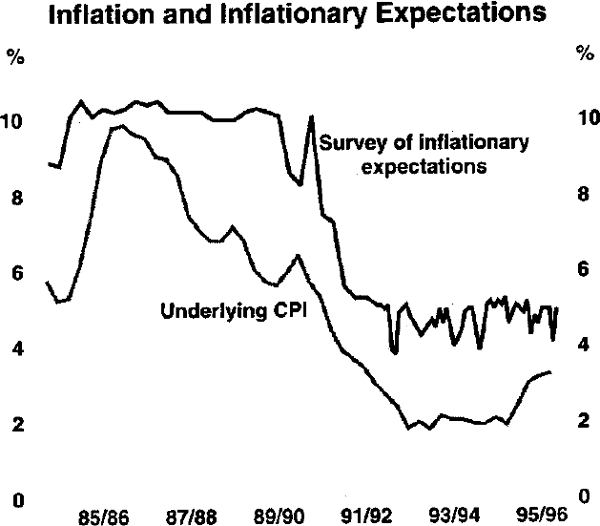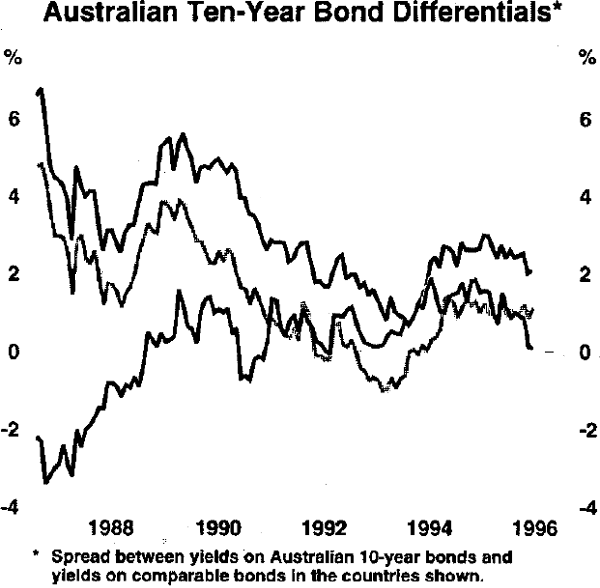Speech What is an Optimal Inflation Target?

Bernie Fraser
Governor
Remarks at a Symposium to mark the 25th Anniversary of the Monetary Authority of Singapore
Singapore –
Introduction
I am pleased to have been invited to this Symposium to mark the 25th anniversary of the Monetary Authority of Singapore, and to have the opportunity to express some views on ‘optimal’ inflation targets. Inflation targets are the central banking vogue of the first half of the 1990s, and it is appropriate to ask whether they are of real value, or just another fad.
I should say at the outset that I doubt there is such a thing as an ‘optimal’ inflation target, certainly one which is universally applicable. Perhaps it would help if we knew what the optimal rate of inflation was, but that is itself a big subject. Some developed countries, such as the United States, Germany and Japan, enjoy low inflation without a formal target, while some Asian economies are able to operate quite efficiently with relatively high rates of inflation. Modesty and realism, therefore, suggest a quest for what is ‘effective’, rather than what is in some sense ‘optimal’.
I would like to offer a few observations on what I think inflation targets should and should not do; to illustrate those observations by reference to recent experience in Australia; and to end with a few general conclusions.
An ‘Effective’ Inflation Target
An effective inflation target would, in my view, have the following attributes.
- It should provide an anchor for inflationary expectations. It would do this by emphasising the central bank's intention to maintain a rate of inflation low enough not to seriously distort decision making in the economy. A low single digit rate is probably sufficient for this purpose.
- It should be a discipline on policy. This would be achieved by having a clear commitment to adjust monetary policy to achieve the target, over a sensible time frame, in a forward-looking way.
- It should carry the broad endorsement of the government and, ideally, of significant groups in the community.
- It should be accompanied by a good deal of transparency and accountability. To this end, the central bank would, for example, indicate regularly and in broad terms how it assesses the prospects for achieving the target, and how policy might be adjusted to achieve it.
On the other side of the ledger, there are a couple of things an effective target should avoid.
- It should avoid being overly ambitious and excessively rigid. Inflation cannot be fine-tuned, and attempts to do so could well add to instability. If that were to occur, and to generate unnecessary costs in terms of economic activity and employment, it could undermine government and community support for the target.
- It should not have too heavy a burden placed on it. Low inflation is not so much an end in itself as a means of delivering sustained growth in activity and employment, and we need to remember that monetary policy alone cannot solve all our economic problems (or even the problem of inflation for that matter).
Australia's Inflation Target
You will not be surprised to hear me say that Australia's inflation target scores highly on my criteria. To this point, it has worked quite well for us, although I acknowledge that our approach might not generalise to other countries.
The target was introduced tentatively about four years ago, without any great fanfare. In contrast to more formal processes, where inflation targets have been introduced by the national government, or by agreement between the government and the central bank, in Australia the target was effectively self-imposed by the central bank. We repeatedly espoused the view that underlying inflation should be held to 2 to 3 per cent over the course of the business cycle; this view soon came to be identified as the Reserve Bank's inflation target. It was then picked up and endorsed by the former Labor Government. It was also supported by the peak trade union body, the Australian Council of Trade Unions (ACTU), in the context of that body's last Accord with the Labor Government. When the new Government came into office last March it was quick to endorse the same target.
Over the past four years, the underlying rate of inflation in Australia has averaged 2¼ per cent. This performance, which has coincided with a period of strong economic growth (averaging more than 3½ per cent), has added a certain amount of credibility and prominence to the target. It has helped to anchor inflationary expectations during the cyclical upswing at much lower levels than we were accustomed to in the 1980s (see Graph 1). More recently, the evidence that inflation remains consistent with the target has helped to bring about a narrowing of the spreads between yields on Australian bonds and those of some other countries (see Graph 2), although that performance will need to be sustained over a longer period for these premiums to decline further.

It has also met the test of being a discipline – and a forward-looking one – on policy. In the second half of 1994, official interest rates were increased decisively and pre-emptively, rising by a total of 275 basis points in three discrete adjustments. These adjustments were made to head off a potential blowout in inflation, even though inflation at the time was still quite low (around 2 per cent) and unemployment was still uncomfortably high (around 9½ per cent). Those higher interest rates were held throughout 1995 and into 1996, when many other countries were easing their monetary policies.

While helping to deliver this discipline on policy, the target is not so narrow or inflexible as to prompt sharp swings in monetary policy and risk an increase in instability. As I said, our aim is to hold underlying inflation to 2 to 3 per cent on average over the course of the business cycle, rather than at every moment. This approach recognises that there is a cyclical element in inflation, which will take the rate outside 2 to 3 per cent on occasions – in both directions. For this reason, the 2 to 3 per cent figures were always expressed as indicating a central tendency for inflation, not the limits of a narrow target band.
At 3.3 per cent, the current 12-months-ended rate for underlying inflation is a little above our target, just as earlier in the recovery phase it was a little below. We are confident that the rate will be back under 3 per cent in the second half of 1996. Because we had anticipated a temporary move above 3 per cent – and had stated our expectation publicly and set policy accordingly – the temporary departure from the medium-term target has been accepted readily by the financial markets and the community generally.
I know that some people see our target as too ‘soft’ and its formulation as too flexible. I do not. If we can contain inflation to an average of 2 to 3 per cent over the course of the business cycle – that is, to an average of 2-point-something over a long period of time – then I believe we will have been quite successful in keeping inflation under control. As to the flexibility of its formulation, that to me is a sensible feature, and one of the strengths of our approach – particularly given the variation in inflation (even in low inflation countries) over the cycle. The Reserve Bank has explicit multiple objectives – which I happen to be in favour of – and the flexibility of our inflation target helps us in pursuing an acceptable balance between growth and stability objectives.
The issue of what is an appropriate degree of flexibility in an inflation target is an important one. There is no unique answer. Given the substantial uncertainties inherent in pursuing a forward-looking monetary policy – which require policy makers to assess probabilities, balance risks and make lots of judgments – we have steered away from narrow, hard-edged target bands for inflation, and from promises that inflation will hardly ever move out of such bands. Participants in financial markets and some others, in their desire for simplicity in a complex and uncertain world, might hanker after such apparently strict targets, but we simply do not believe such a commitment can be made credible.
It is performance that counts in building credibility, not the announcement of tough targets. In our view, a narrow, supposedly hard-edged band risks a serious loss of credibility when the edges prove, as they inevitably will, to be less hard than they earlier appeared. On the other hand, a band wide enough to encompass the genuine uncertainty inherent in inflation formation and forecasting processes could well have to be so wide as to lack any real credibility.
For these reasons, we believe it is best to indicate a central tendency for inflation that we are determined to achieve over the course of the cycle; to avoid promising to hit it at every reading; but to be prepared to adjust policy in a way that is consistent with the target we have defined.
Some General Conclusions
I will end with three general conclusions.
- A point to be remembered about targets – and one which applies whether the target relates to inflation or to other economic performance measures such as budget deficits and unemployment – is that they are not without their risks. Properly formulated and sensibly pursued, they can help to deliver results – particularly by sharpening the focus and emphasising the commitment of policy makers (and others in the community) to tackle major economic imbalances. But it needs to be the right target; the blind pursuit of an inappropriate target will introduce unhelpful rigidities and biases into policy making. If a compelling case exists to have an announced target for inflation (and it may not), the trick is to have one which delivers the hoped-for benefits but avoids the downsides, including the risks to credibility of failure to meet the target.
- At the end of the day, what matters most is not the numerical or verbal precision of any inflation target, but the strength of the commitment that lies behind it, and the wisdom with which it is pursued in conjunction with growth and employment objectives. I doubt that these things can be reflected adequately in legislation, or in agreements between governments and central bank governors. Performance over a long period is the main test, as low inflation countries like Germany and Japan have demonstrated. A degree of flexibility in the formulation and implementation of a target is likely to improve its public face – and hence its longevity.
- Any regime needs to pass the test of time – that is, to cope with more than one phase of the business cycle. It is early days yet for most of the countries which have adopted some kind of inflation target – and, for many countries, those days have seen more softness than strength in economic activity. It is relatively easy to hold inflation down when there is considerable slack in the economy. The real test comes when pressures start to build in key sectors of the economy. In that sense, the real test of the worth and durability of inflation targets in some countries lies in the future. In our own case, where the target has been held during a period of quite strong growth, we would claim we have passed the first test. Further tests are on the horizon but, to this point, our experience with our inflation target has been encouraging.